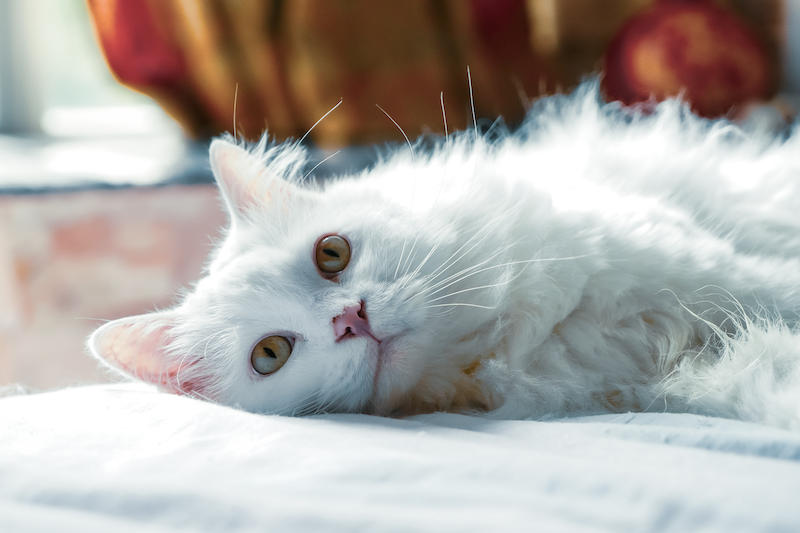Popular posts
Why Cats Get Hairballs and How To Remedy Them
This post contains affiliate links and Meowtel will be compensated if you make a purchase after clicking on the links.
Have you ever wondered what the technical term for a hairball is? Well, it's trichobezoar, but any cat parent knows that what Simba expels from his little body isn’t just hair nor is it in a nice little ball. It’s often undigested hair mixed with bile and sometimes even food, and it tends to come out in a cylindrical shape.
Did you know?
- The reason cats get hairballs more than other animals is a combination of how much they groom and the anatomy of their tongues. Unlike any other animal, the tiny spikes that feel like sandpaper, known as filiform papillae, slant backward. A study published by researchers Alexis C. Noel and David L. Hu in the journal Proceedings of the National Academy of Sciences of the United States of America (PNAS) state, filiform “papilla is in fact scoop shaped, enabling it to use surface tension forces to wick saliva.”1
- Hairballs are a side effect of a clean kitty. The Cornell Feline Health Center at Cornell University College of Medicine states:
As your cat grooms herself, she swallows a lot of the dead hair that has come loose. This is because… [filiform] papillae… propel the indigestible hair down her throat and into her stomach. While most of this hair eventually passes through the animal's digestive tract and is excreted intact in the feces, some of it remains in the stomach and gradually accumulates into a wet clump - the hairball.2
Are some cats more prone to hairballs?
Older cats, cats who shed a lot, and longer-haired cats are more prone to hairballs than younger cats or kittens. As a cat ages, their grooming skills increase therefore so do their hairballs. Of course there are exceptions to this rule. Senior cats with arthritis or Persians tend to have less hairballs since they are unable to groom as much. Noel and Hu found during their research that, “if the [filiform] papillae cannot reach the skin much of its fur cannot be accessed, making the cat ‘ungroomable.’ Long-haired domestic breeds, such as Persian domestic cats, are notorious for their matted fur if not cared for properly.”1
When should you be concerned about hairballs?
If your cat Simba is prone to hairballs, it’s not unheard of for him to have one every 1-2 weeks. However, if Simba demonstrates any of the following, contact your vet immediately:
- Lethargy
- Lack of interest in food (i.e. doesn’t eat for 1+ days)
- Continuous coughing without any success getting anything up
- Distended (swollen) belly
- Change in bowel movements in conjunction with one or more above symptoms
These symptoms could mean that Simba has a blockage that is causing bodily harm. To determine this, your vet may require an exam, x-rays, and bloodwork. Joanna Guglielmino, DVM, tells the Cornell Feline Health Center at Cornell University College of Medicine, “If a blockage is detected, surgery may be the only way to remove the hairball. More often, therapy will center on protecting the intestine through several days of clinical care that includes intravenous rehydration and the use of a laxative to move the hairball through the digestive tract.”2
Is there anything you can do to help with hairballs?
Supplements & Gels for Hairballs
There are commercial hairball treatments and supplements you can try such as Vetoquinol Laxatone Lubricant for Hairballs. The idea is that it lubricates the esophagus and gastrointestinal tract to help move the hair through the body to exit with feces. Natalie Waggener, DVM, of South Boston Animal Hospital, suggests using digestive aids that include psyllium seed like Vet's Best Hairball Relief Digestive Aid.
At-Home Hairball Remedies
If you want to try a more natural route, speak to your vet about adding a teaspoon of olive oil or butter weekly into Simba’s diet. It’s also been said that upping Omega 3s like salmon oil can help as well. Cat grass could also help since the fiber in the grass helps bind and move everything along.
Brushing & Grooming to Prevent Hairballs
Getting into the habit of brushing Simba can be very beneficial. Not only does brushing feel great, it helps remove the dead fur that he’d lick into his system. A popular brush for taking out the undercoat is the FURminator.
If Simba lets you do a little more than grooming, try waterless shampoo and/or hypoallergenic grooming wipes. These added into the mix will help lift even more dead fur off of his little body. If he continues to have hairballs but refuses to let you brush or groom him yourself, you may need to schedule regular trips to the groomer.
If your cat is prone to hairballs, be sure to let your Meowtel sitter know. Your sitter will be sure to follow any hairball instructions like daily brushing or gel administration. We love Simba as much as you do and will make sure he stays healthy while you’re gone.
Photo by C.SHII via Unsplash


